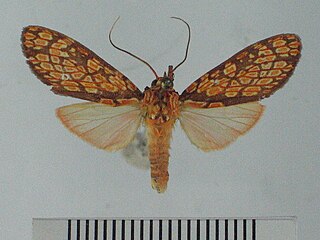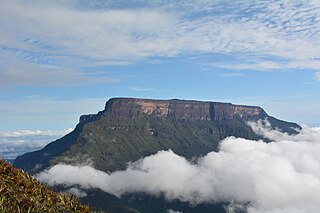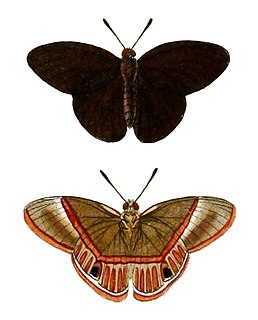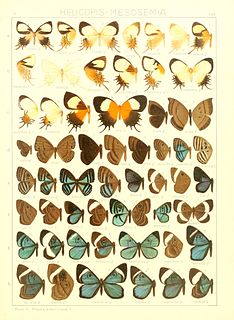
Cresera is a genus of moths in the family Erebidae. The genus was described by Schaus in 1894.

Catocala ilia, the Ilia underwing, beloved underwing or wife underwing, is a moth of the family Erebidae. The species was first described by Pieter Cramer in 1776. It can be found in the eastern part of the United States as well as southern Canada. Subspecies Catocala ilia zoe can be found in California and Arizona.

Junonia genoveva, the mangrove buckeye, is a butterfly of the family Nymphalidae. The species was first described by Pieter Cramer in 1780. It is found in North America from southern New Mexico, southern Arizona, southern Texas, and southern Florida south through the West Indies, Mexico and Central America to Argentina. Rare strays can be found up to southeastern California, southeastern Colorado and central Florida. In the Cayman Islands, it is known as the Caribbean buckeye.

Heliconius numata, the Numata longwing, is a brush-footed butterfly species belonging to the family Nymphalidae, subfamily Heliconiinae.

Cresera ilioides is a moth of the family Erebidae first described by William Schaus in 1905. It is found in French Guiana, Guyana, Venezuela, Peru and Bolivia.

Cresera optima is a moth of the family Erebidae first described by Arthur Gardiner Butler in 1877. It is found in French Guiana, Guyana, Amazonas, Ecuador and Colombia.

The Eastern Tepuis, also known as the Roraima–Ilú range, is a mountain chain stretching for some 60 kilometres (37 mi) along the border between the disputed territory of Guayana Esequiba in Guyana, Venezuela and, to a small extent, Brazil. It runs in a northwesterly direction from the tripoint of these countries, closely following the Guyana–Venezuela border, with a single major peak (Uei-tepui) to the south, on the Brazil–Venezuela border. Moving northwest from Uei-tepui (2,150 m), the main summits of this chain are Roraima-tepui (2,810 m), Kukenán-tepui (2,650 m), Yuruaní-tepui (2,400 m), Wadakapiapué-tepui (2,000 m), Karaurín-tepui (2,500 ), Ilú-tepui (2,700 m), and Tramen-tepui. The minor peak of Wei-Assipu-tepui lies entirely outside Venezuela, on the border between Brazil and Guyana. Additionally, there are a number of minor plateaus which form a chain between Uei-tepui and Roraima-tepui. Ilú- and Tramen-tepuis are often treated together since they are joined by a common base.

The Ilú–Tramen Massif is a tepui massif in Bolívar state, Venezuela. It is the northernmost member of the Eastern Tepuis chain and comprises two major plateaus: the larger Ilú-tepui to the south and Tramen-tepui to the north. With a maximum elevation of around 2,700 metres (8,900 ft), Ilú-tepui is the taller of the two peaks. Both tepuis have open, rocky summit plateaus, with a combined summit area of 5.63 km2 (2.17 sq mi). They lie just north of Karaurín-tepui.

Carales astur, the astur moth, is a moth of the family Erebidae. It was described by Pieter Cramer in 1777. It is found from Mexico to Bolivia and east to Suriname.

Chetone catilina is a moth of the family Erebidae. It was described by Pieter Cramer in 1775. It is found in French Guiana, Venezuela and Suriname.
Cresera intensa is a moth of the family Erebidae. It was described by Walter Rothschild in 1909. It is found in French Guiana, Brazil and the Amazon region.
Hypercompe eridanus is a moth of the family Erebidae first described by Pieter Cramer in 1775. It is found in Colombia, Suriname and French Guiana.

Hypocrita celadon is a moth of the family Erebidae. It was described by Pieter Cramer in 1777. It is found in Argentina, French Guiana, Suriname and Nicaragua.

Idalus vitrea is a moth of the family Erebidae. It was described by Pieter Cramer in 1780. It is found in Mexico, Guatemala, Honduras, Costa Rica, Panama, Paraguay, Peru, French Guiana, Bolivia, Brazil, and Venezuela.

Euselasia is a genus of butterflies in the family Riodinidae. They are present only in the Neotropical realm. The genus was erected by Jacob Hübner in 1819.

Mesosemia is a genus in the butterfly family Riodinidae present only in the Neotropical realm.

Leucochimona is a butterfly genus in the family Riodinidae present only in the Neotropical realm.
Sychesia dryas is a moth in the family Erebidae. It was described by Pieter Cramer in 1775. It is found on the West Indies, Guatemala, Costa Rica, French Guiana, Brazil, Peru, Ecuador, Bolivia, Suriname, Venezuela and Trinidad.
Zatrephes crocos is a moth in the family Erebidae. It was described by Pieter Cramer in 1777. It is found in French Guiana, Suriname and Venezuela.
Zatrephes nitida is a moth in the family Erebidae. It was described by Pieter Cramer in 1780. It is found in French Guiana and Suriname.















